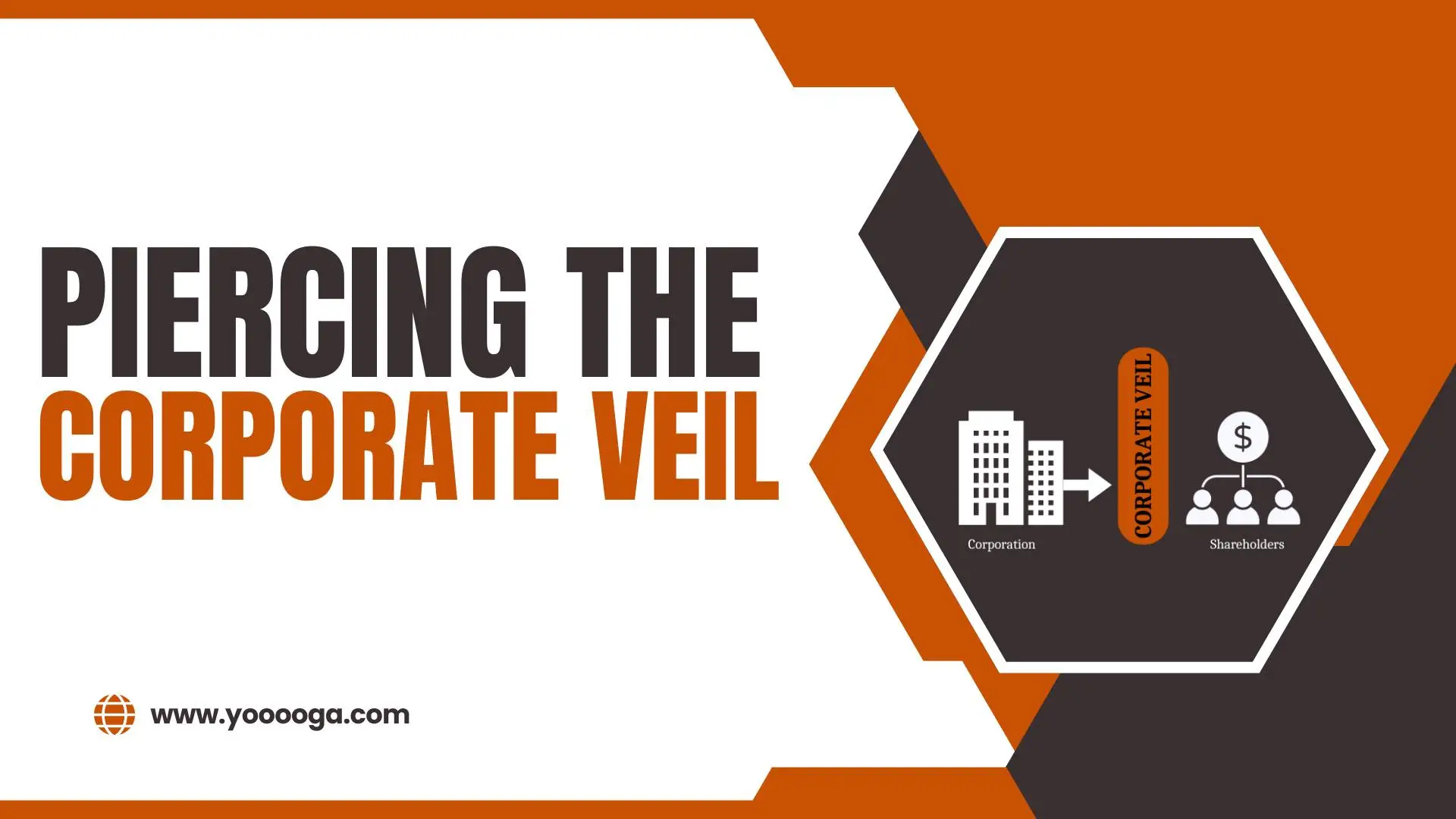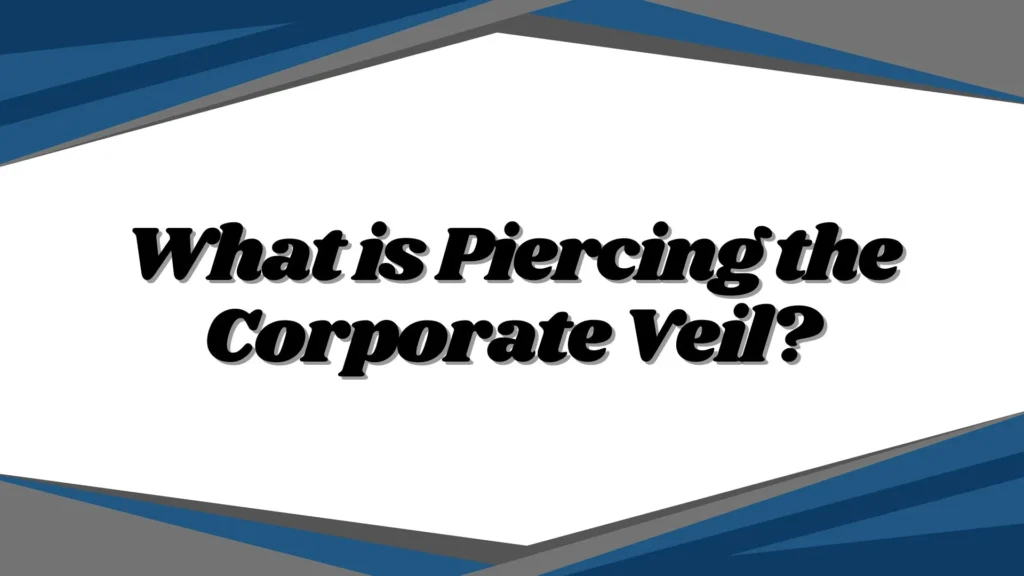GENERAL
Piercing the Corporate Veil: Understanding the Risks and Safeguarding Against Personal Liability

Incorporating a business or establishing a limited liability company (LLC) is often seen as a strategic move to protect personal assets from the risks associated with running a business. The concept of limited liability is designed to ensure that, in the event of business losses or debts, the personal assets of the owners or shareholders remain insulated from corporate liabilities. However, this protection is not absolute. In certain circumstances, courts may allow what is known as “piercing the corporate veil,” effectively stripping away this protective barrier and holding owners personally liable for the obligations of the business. Piercing the corporate veil is a legal action that allows courts to hold business owners personally liable for the company’s debts and obligations by disregarding the company’s separate legal entity status.
This article delves into the intricacies of piercing the corporate veil, the conditions under which it may occur, and the defensive measures that business owners can take to avoid such scenarios.
Table of Contents
What is Piercing the Corporate Veil?
Piercing the corporate veil is a legal concept that enables courts to disregard the separate legal entity of a corporation or LLC and hold its owners or shareholders personally liable for the entity’s debts and obligations. This doctrine is typically invoked when the corporate structure is misused or when maintaining it would perpetrate fraud or injustice. The corporate veil is considered an essential element of corporate law, providing the foundation for the limited liability that encourages entrepreneurship and investment. However, when a business is used as a mere facade to shield wrongful or fraudulent activities, courts may decide that the veil must be pierced to ensure fairness and accountability.

Criteria for Piercing the Corporate Veil
While piercing the corporate veil is a drastic measure, courts are generally reluctant to take this step unless there is compelling evidence of misconduct. Several factors can influence a court’s decision to pierce the corporate veil:
- Fraud or Deception: Courts are particularly vigilant when it comes to fraud. If it is shown that the corporation was used as an alter ego to deceive creditors, evade obligations, or commit fraudulent acts, the corporate veil may be pierced. The intention behind forming a corporation is crucial; if it is to perpetrate fraud, the limited liability protection may be stripped away.
- Commingling of Assets: One of the most common reasons for piercing the corporate veil is the commingling of personal and corporate assets. When owners fail to maintain separate accounts and records, treating the corporation’s assets as their own, it becomes difficult to distinguish between the corporation and its owners. This lack of separation can lead to a court finding that the corporation is merely an alter ego of its owners.
- Inadequate Capitalization: If a corporation is undercapitalized—meaning it lacks sufficient capital to cover its debts and obligations—this can be a sign that it is not a genuine, separate entity. Courts may view undercapitalization as evidence that the owners never intended for the corporation to function independently and that they were merely using it to shield themselves from liability.
- Failure to Follow Corporate Formalities: Corporations and LLCs are required to adhere to certain formalities, such as holding annual meetings, keeping minutes, and maintaining proper records. Failure to follow these formalities can indicate that the corporation is not being treated as a separate entity by its owners, increasing the likelihood that the veil will be pierced.
- Misrepresentation of the Corporate Structure: If owners mislead creditors or other third parties about the nature of the corporation or imply personal liability where none exists, this can also lead to piercing the corporate veil. Transparency in the corporate structure is essential to maintaining the integrity of limited liability protection.
Case Examples and Legal Precedents
Historically, courts have been more likely to pierce the corporate veil in cases involving small, closely held corporations, where the distinction between the corporation and its owners is often blurred. Large, publicly traded corporations, on the other hand, typically have more robust structures and formalities in place, making it less likely that the corporate veil will be pierced.
For example, in a notable case involving a small business, a court found that the owners had failed to maintain separate bank accounts, neglected to hold annual meetings, and used corporate funds for personal expenses. These actions led the court to pierce the corporate veil and hold the owners personally liable for the corporation’s debts. In contrast, larger corporations with multiple layers of management and rigorous adherence to corporate formalities are generally better protected against such claims.
How to Protect Against Piercing the Corporate Veil
Given the serious implications of having the corporate veil pierced, business owners must take proactive steps to safeguard against this risk. Here are some key measures to consider:
- Maintain Separate Accounts and Records: One of the most critical steps in protecting the corporate veil is to keep personal and corporate finances separate. This includes having distinct bank accounts, not using corporate funds for personal expenses, and ensuring that all transactions between the corporation and its owners are properly documented. For instance, if the corporation lends money to an owner, there should be a formal loan agreement with clear terms for repayment, including interest.
- Adhere to Corporate Formalities: Regularly hold and document board meetings, annual meetings, and any other required corporate gatherings. Even in the case of a single-member LLC or a closely-held corporation, it’s important to observe these formalities. Proper documentation, such as minutes of meetings and resolutions, should be kept in an organized and easily accessible manner. These records can serve as crucial evidence that the corporation is a legitimate, separate entity.
- Ensure Adequate Capitalization: At the time of incorporation, ensure that the business is adequately capitalized to cover its expected liabilities. This means having enough financial resources to meet the company’s obligations without relying on the personal assets of the owners. Adequate capitalization is not only a legal requirement but also a practical necessity for the long-term viability of the business. Many companies, especially large corporations, choose to incorporate in Delaware due to its favorable business laws and the legal protections offered.
- Avoid Commingling of Assets: Commingling personal and corporate assets is a surefire way to invite scrutiny. Every transaction involving corporate funds should be clearly accounted for, and personal and corporate expenses should never be mixed. If a corporation pays for an owner’s personal expenses, it should be documented as either a loan or compensation, with appropriate tax implications considered.
- Be Transparent About the Corporate Structure: Clearly indicate the corporate or LLC status on all business communications, including contracts, invoices, and letterheads. This helps to set proper expectations with creditors and other third parties and reinforces the understanding that the corporation is a separate legal entity.
- Consult Legal and Financial Professionals: Regular consultation with legal and financial professionals can help ensure that the corporation is compliant with all necessary formalities and is adequately protected against potential claims. These professionals can provide guidance on structuring transactions, maintaining records, and addressing any issues that may arise in the course of business operations.
Conclusion
Piercing the corporate veil is a legal remedy that courts reserve for situations where the corporate structure has been misused or where maintaining the structure would result in injustice. While the prospect of personal liability can be daunting, business owners can significantly reduce the risk by diligently observing corporate formalities, maintaining clear boundaries between personal and corporate assets, and ensuring that the corporation is adequately capitalized. By taking these precautions, business owners can protect the integrity of their corporate veil and enjoy the benefits of limited liability with greater confidence.
Understanding the principles and risks associated with piercing the corporate veil is essential for any business owner. With careful planning and adherence to legal requirements, the likelihood of a court disregarding the corporate entity and imposing personal liability can be minimized, allowing business owners to focus on growing and managing their enterprises effectively.
-

 GENERAL6 months ago
GENERAL6 months agoChristofle – For Those Who Dream of Family Heirloom Silver
-

 SPORTS8 months ago
SPORTS8 months agoDiscover the World of Football with Streameast: Watch Your Favorite Leagues and Tournaments
-

 GENERAL4 months ago
GENERAL4 months agoUncovering the World of кинокрадко: The Dark Side of Film Piracy
-

 GENERAL2 months ago
GENERAL2 months agoATFBooru: Anime, Gaming, and Subculture Imageboard























